Menu
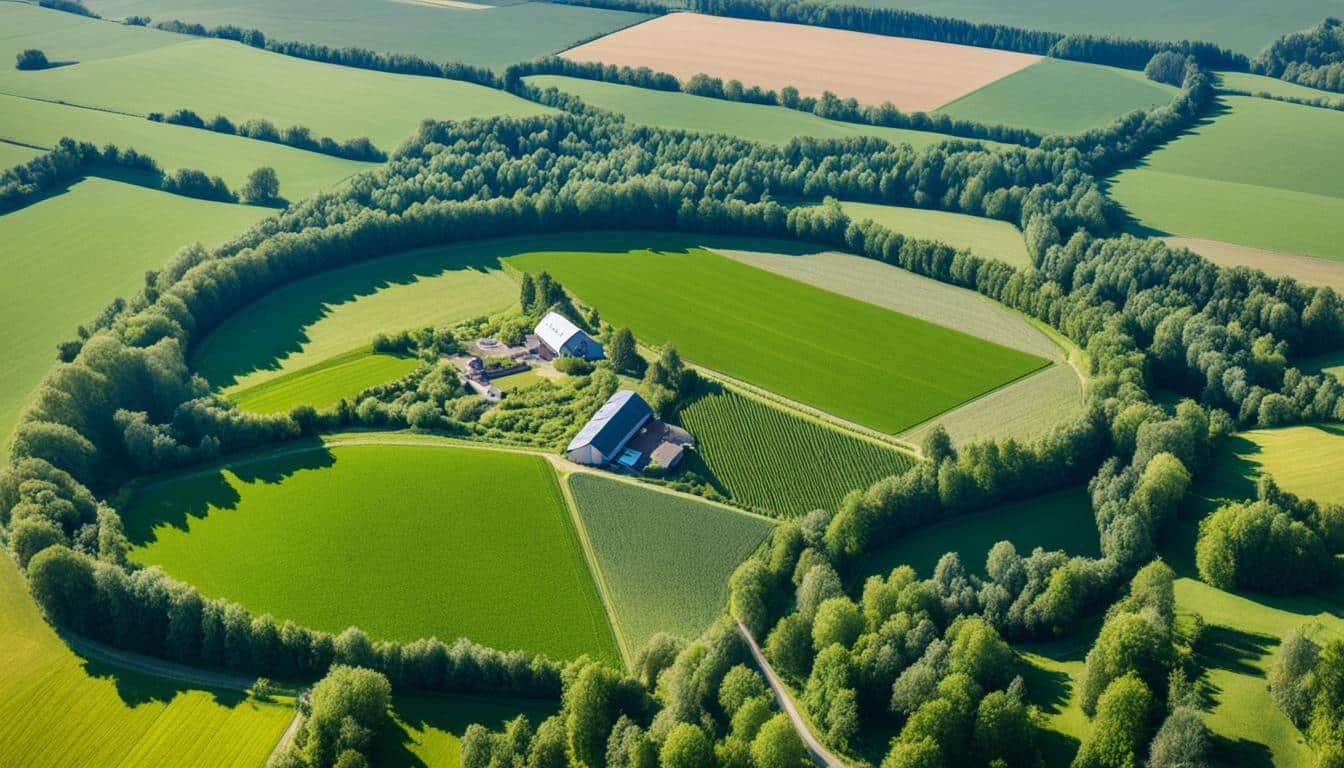
Did you know, Germany leads the world with 42% of international biodynamic farming space? By 2022, biodynamic methods covered 255,051 hectares worldwide. Reinventing agriculture, this movement focuses on using ecological and spiritual approaches. Rudolf Steiner’s principles guide farmers to see soil, plants, and animals as linked.
Germany shines in biodynamic farming thanks to over a thousand farms and the support of Demeter. These farms are seen as living in harmony with nature. They are encouraged to be self-reliant. Demeter’s role is vital, certifying products and aiding in their distribution. This effort makes Germany a key player in the shift towards greener farming.
Biodynamic agriculture goes beyond simple organic methods to connect us with nature. This approach pre-dates the organic movement. It enhances soil health, plant growth, and the balance of our environment.
In 1924, Rudolf Steiner started biodynamic farming with some key lectures. He saw the dangers of chemicals in farming on soil and wildlife. To solve this, he connected agricultural practices with his anthroposophy philosophy. This made biodynamic farming more than just about growing food. It became a way to live in harmony with the earth, animals, and the larger cosmos.
Steiner didn’t want his work to stay the same. He believed in always testing and improving the methods of biodynamic farming. This way, it could keep up with changes over time.
Maria Thun created a special calendar for planting and pruning. It’s based on moon phases and stars. Using this calendar aims to make crops healthier and more productive. It also makes sure farming is always in tune with the universe.
Under biodynamic farming, using chemical soil treatment is a big no. Instead, farmers use special preparations to make soil and plants better. Each farmer’s work is like a piece of a puzzle. Together, they make a landscape that’s full of life and able to withstand challenges. When you see Demeter certification on biodynamic produce, you know it’s met the highest quality standards.
In Germany, biodynamic farming started because of Rudolf Steiner’s work. The farmers found his talks inspiring. They wanted to farm in ways that helped the earth and were good for their crops. This section looks at how biodynamic farming started in Germany and how it grew over time.
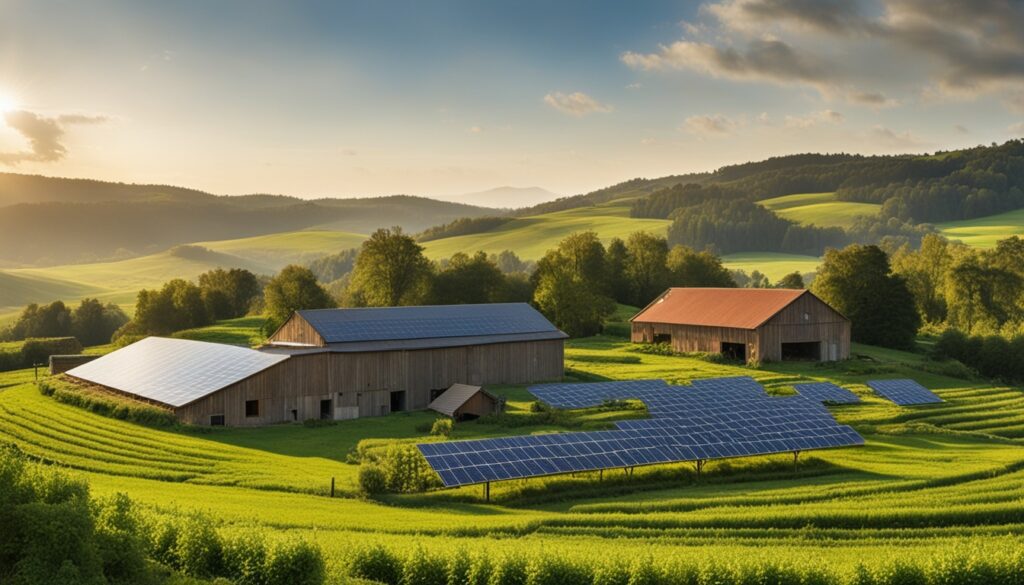
Germany’s move to biodynamic farming began with Steiner’s ideas. His talks taught farmers to work with nature, in a way that didn’t hurt the land or their crops. After his lectures, a group of farmers joined together. They tested Steiner’s methods. Then, they started the Demeter mark. This mark shows products grown in a special, natural way. Now, it’s known all over the world.
During wars, Germany’s farmers still believed in biodynamics. After the wars, these natural farming ideas became very popular. Now, over 1000 farms in Germany follow these special methods. These farms are a big part of a worldwide movement for natural farming. The Demeter International group formed in 2020 to bring these farmers together. And, Germany leads the world in how much land is used for biodynamic farming, with 42%.
German biodynamic farms follow strict rules to care for the earth. They are examples of how farming can be good for nature and for people. A lot of farmers around the world now follow these principles.
Biodynamic agriculture is a holistic method. It seeks to create a self-sufficient, ecological harmony promoting ecosystem. This approach connects and balances different farm parts, respecting and revitalising natural processes.
Biodynamic farming treats the farm as a living system. It involves managing crops, animals, and soil carefully. The Demeter Biodynamic Farm Standard aims to ensure holistic farming. It does this by requiring that at least 50% of the feed for animals comes from the farm. It also sets aside 10% of the farm for biodiversity. These rules cut down heavily on the need for outside help.
Biodynamic farming also sets high ecological and ethical goals. Over 5,000 farms around the world are certified by Demeter International. They use compost from natural materials for their soil. This includes yarrow, chamomile, and oak bark. They also use horn manure and horn silica sprays. These methods help keep the soil healthy and support strong plant growth.
Farmers follow strict ethical practices. They respect the farm’s lifecycle. They also align planting and harvesting with the natural cycles. This is done using specific biodynamic calendars. These actions protect the environment for the future.
Biodynamic farming uses a complete method to balance nature. It regenerates the land through crop, soil, astronomical, and animal care. These methods help agriculture become more sustainable and regenerative.
Soil and crop care in biodynamic farming is very detailed. It includes using *biodynamic compost* to make soil livelier. This compost controls nitrogen and boosts microbe variety, leading to better composting. *Biodynamic compost* also adds more carbon to nature, helping climate balance.
Choosing and rotating crops keeps soil rich and healthy. This cycle shows how biodynamic farming restores the earth.
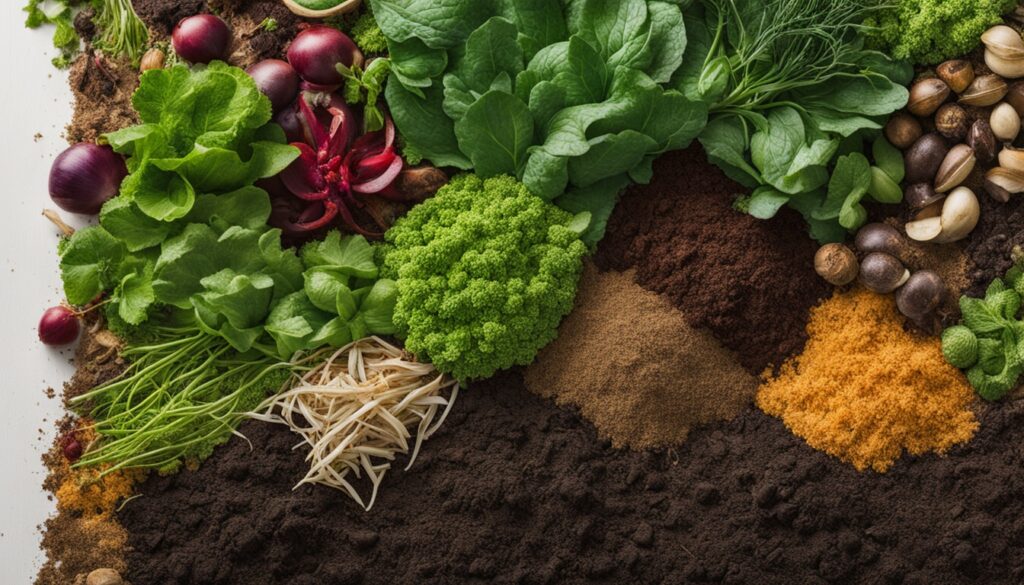
Biodynamic farming also looks at the sky for guidance. Special calendars help farmers know the best times to work their fields. These times are picked to match with nature’s big cycles.
This way, farming becomes one with the universe, making plants stronger and more productive.
Having animals on a biodynamic farm is key for the environment. Farms must follow the Demeter Biodynamic Farm Standard to use animals right. This means more than half the animal food must come from the farm. Also, a part of the land must be wild to support different life.
Animals help the farm’s health by their manure. This becomes natural fertiliser, which makes the soil and the wild stronger. This system allows the farm to care for itself, creating a balanced and healthy place.
In Germany, a lively biodynamic community shows how organic agricultural systems can be put into action. This way of farming started in 1924, after Rudolf Steiner gave a series of important talks. Now, 42% of the world’s biodynamic farming takes place in Germany. Many people are involved, such as farmers, buyers, and groups who support this type of farming.
Demeter is a central part of biodynamic farming. They are known worldwide for their strict rules in farming methods. Yet, Demeter does more than just checking farms. They also help with selling products locally. This all helps keep farming good for the earth, people, and spirits.
Here are some numbers that show how much Germany does in biodynamic farming:
Germany’s work in biodynamic farming is very deep. It’s not just about the numbers. The country uses these methods in a wide range of farming, from grapes to cotton. They even take care of silkworms. By doing this, they’re showing that biodynamic ideas really work in farming today. This has a big effect on how farming happens all over the world.
I watch the farming world closely and I know how Demeter certification is seen. It’s a top mark for organic goods, making sure they meet tough biodynamic rules. The process checks if farms are really following these key farming principles.
Getting certified under Demeter is thorough and demands the best. It started with Rudolf Steiner’s ideas in the 1920s. Farms need ten percent reserved for nature, like forests and wetlands. They also must change where they grow crops each year to keep the soil healthy.
Plus, they use special mixtures of herbs, minerals, and animal products to boost the soil.
Meeting the Demeter standard is tough but covers a lot to ensure the best is reached. It’s not just about the farms. It looks at the processing too, with sixteen different areas checked.
They don’t allow artificial chemicals, synthetic fertilisers, or certain farming methods. Livestock gets most of its feed from the farm and some must be kept as natural spaces.
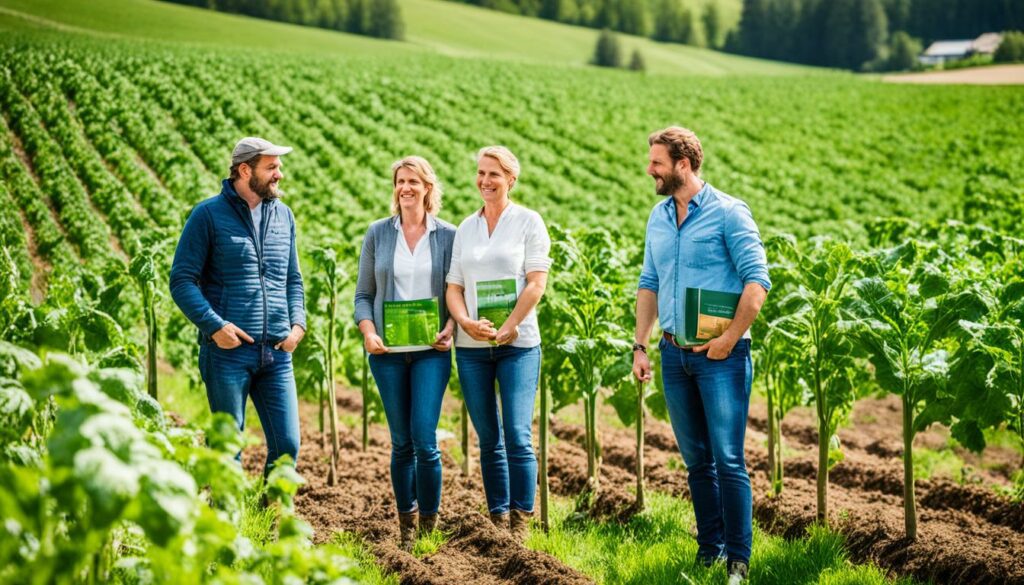
Demeter makes sure the products are eco-friendly and high quality. They ensure no artificial stuff touches the products. This is good news for buyers who want natural goods.
Hanson from Jack Rabbit Hill thinks biofarming is better for the earth than just traditional or even organic methods.
| Aspect | Biodynamic Farms | Conventional Organic Farms |
|---|---|---|
| Crop Management | Rotation guidelines with max 2 years | Limited rotation guidelines |
| Animal Feed | 30% Demeter certified, 20% organic | 50% organic |
| Chemical Usage | Prohibited | Limited but allowed |
| Biodiversity Requirements | 10% Natural reserve | N/A |
Demeter certification shows a strong dedication to top biodynamic goods. This approach keeps farming sustainable and responsible.
The biodynamic agricultural community in Germany leads in caring for the environment. It uses innovative farming techniques that are now used in 65 countries. Germany plays a big part, covering 42% of the world’s biodynamic farming land. This is thanks to the efforts of farmers, researchers, and buyers who work hard to spread biodynamic ways.
Between 1924 and 1939, a research group focused on biodynamic farming attracted 800 members worldwide. These efforts grew with time, leading to the formation of the Biodynamic Federation in 2020. This came about when Demeter International and the International Biodynamic Association joined hands.
Table representing top countries implementing biodynamic agriculture showcases:
| Country | Hectares (2022) | Global Percentage |
|---|---|---|
| Germany | 107,121 | 42% |
| Italy | 48,990 | 19% |
| France | 33,157 | 13% |
| Other Countries (Average) | 1,750 | N/A |
Biodynamic farming wouldn’t be where it is today without certification bodies. Demeter International is a key player in this. Starting back in the early 20th century, 250 people in Germany focused on biodynamic farming. Their work’s impact stretched to places like Switzerland and beyond, across varied crops and practices.
The biodynamic community remains strong, adapting old wisdom to new challenges. This ensures that Germany continues to lead in green farming and innovation in agriculture around the world.
Sustainable agriculture, especially biodynamic farming, brings many environmental benefits that are crucial for the future of farming. It uses natural processes to keep soil healthy and fertile. This is done without using harmful chemicals.
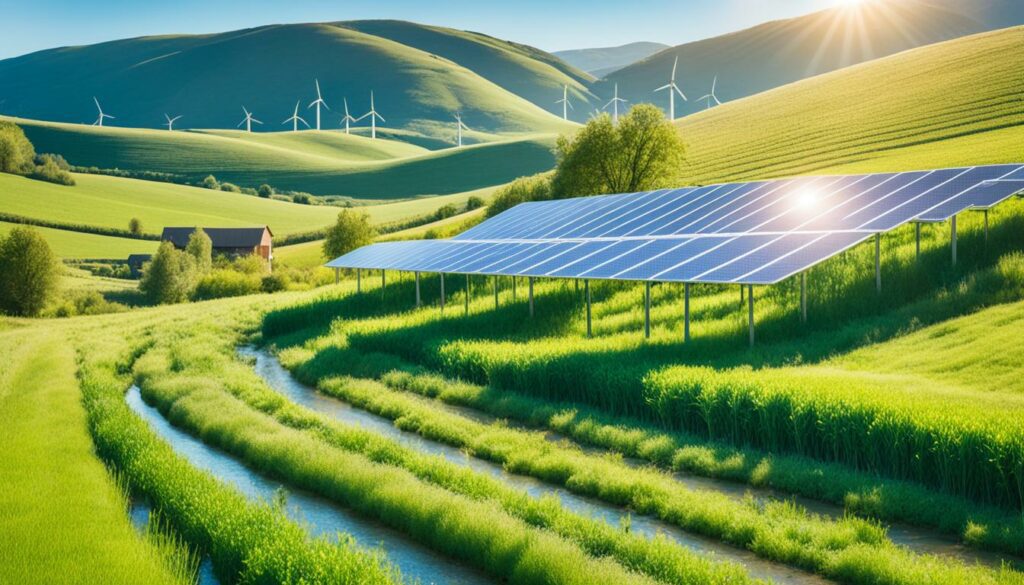
Sustainable farming’s positive impact on the environment is huge. For instance, using cover crops helps reduce nitrogen and phosphorus losses, which is great for water quality. It also helps bring back more plant and animal life, boosting biodiversity (Barral MP et al., 2015).
Studies show that using compost and organic materials can improve how well soil absorbs water. This helps cut down on harmful leaks and emissions. It’s a win for the environment (Borchard N et al., 2019; Barthod J et al., 2018).
Making sure soils stay healthy is key in sustainable farming. Long-term research in Europe and China proves this approach boosts soil quality. Farming methods like growing different crops together and not tilling as much help a lot. They make the soil life-rich, which is vital for growing good food (Bowles TM et al., 2017).
In Germany, the Ackerbaustrategie 2035 promotes these healthy soil practices to grow a variety of plants (BMEL, 2021). This shows that looking after the soil is critical for strong and lasting farming systems.
The big plus of sustainable farming is that it can keep going for a long time. It helps keep the soil safe for growing food, so future farms can still be prosperous. Research globally backs this up, showing that sustainable farming can reduce the damage caused by bad weather (Bell LW et al., 2014).
Also, choosing sustainable ways can be good for the economy. In Germany, it could mean €8.5 billion more every year (Bartkowski B et al., 2021). This is because it helps with the climate and water, making farming and the environment healthier and more balanced.
Biodynamic farmers in Germany face numerous hurdles that hurt their work and goals for sustainability. They deal with economic limits, rules, and market changes that make it hard to run their farms. Even though people want organic food, financial and rule issues create big challenges.
Economic issues hit biodynamic farms hard. The cost of making products is rising, leading to many farms closing. With inflation, organic sales have decreased by 4.1%, showing the strain they’re under. Farmers barely making ends meet get just 56 cents for a litre of milk. But they need to earn 14 cents more to cover their costs.
Understanding and following regulations is another tough part for these farms. The German government plans to have more organic farms by 2030. Yet, deals like the TTIP with the US and the EU’s links with Mercosur could harm small farms in Germany.
| Challenge | Impact |
|---|---|
| Rising Production Costs | Reduction in the number of farms operating daily. |
| Inflation | Decreased sales and tighter profit margins for organic products. |
| Regulatory Challenges | Potential adverse effects from international trade agreements. |
| Market Dynamics | Shift of consumers from organic to discount supermarkets. |
To sum up, the challenges for biodynamic farms in Germany are many and need careful planning and help from policies to overcome. Despite these obstacles, growing the organic market is crucial. With continued hard work, a stronger and more sustainable biodynamic farm sector is possible.
German biodynamic farms are leading the way in sustainability and innovation. One standout is Buschberghof. This 90-hectare farm became a Community Land Trust in 1968. It’s famous for its regenerative farming methods and a unique Community Supported Agriculture (CSA) scheme. Over 90 consumer households take part, enjoying more than 50 kinds of vegetables and thirteen types of bread made on the farm. This model has been running successfully for over two decades.
Buschberghof shows how to be economically successful in agriculture. Its ventures were worth 330,000 euros in one season (2009/10). Five families work on the farm, doing a mix of activities like farming, keeping animals, gardening, and making milk and bread. The farm also welcomes twelve mentally handicapped workers, showing a real community spirit.
In 2009, Buschberghof won the Prize for Innovation in Ecological Farming from the German Ministry of Agriculture, a big moment for the farm and the biodynamic movement.
Gérard Bertrand is also making a huge impact. He turned 600 hectares of vineyards into biodynamic sites across twelve of his fourteen estates. This big change shows large-scale biodynamic farming is indeed possible and beneficial.
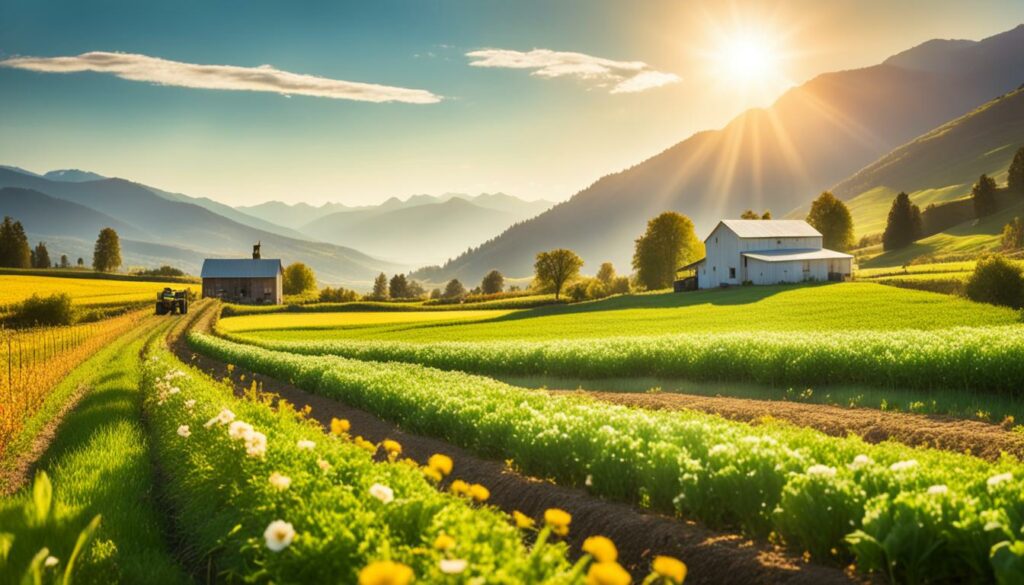
| Farm | Size | Key Features |
|---|---|---|
| Brodowin | 2,500 ha | Largest biodynamic farm in Germany, employs 150 workers, supports 160 dairy cows, 250 goats, and 2,400 chickens, grows 15 types of vegetables |
| King Estate | 475 acres | Largest biodynamic vineyard in the U.S., certified by Demeter |
| Buschberghof | 90 ha | Community Land Trust, CSA scheme, multiple vegetable varieties, integrates mentally handicapped individuals |
| Emiliana Vineyards | 1,600 acres | World’s largest biodynamic vineyard situated in Casablanca, Chile |
By using Demeter methods, these farms are showing the way in biodynamic farming. Their stories demonstrate how building a self-sustaining ecosystem not only helps farms grow but also brings communities together and keeps the environment healthy.
Looking at different ways of farming in eco-friendly methods, it’s important to know the differences. This includes the benefits of organic, biodynamic, and regenerative farming. Each type contributes to making farming more sustainable. We will discuss how they differ and their impact on the land.
Organic farming stands out for avoiding synthetic fertilisers and pesticides. It prefers natural inputs like compost to keep soil healthy. Over time, this boosted the soil’s organic matter levels and nitrates. This is good for the soil’s structure and crucial for plant growth.
Regenerative farming focuses heavily on ecosystem health. It uses methods such as diverse crop rotations and cover crops to improve soil. This led to better soil fertility. The soil also saw an increase in important nutrients that plants need to grow strong.
Biodynamic farming includes spiritual and cosmic ideas, making it unique. It works within the balance of nature, using special planting calendars. Soil health is central but it also looks beyond, connecting the farm to the universe.
Biodynamic farming and regenerative agriculture share a focus on soil health. Korean Natural Farming merges these ideas with spiritual engagement and modern practice. It has been scientifically proven to enrich the soil, showing its effectiveness with local resources.
When we compare these farming styles, they show different ways to reach sustainability. Organic, biodynamic, and regenerative farming each have their strengths. They offer varied routes to sustainable, eco-friendly farming based on their unique beliefs and practices.
The future looks bright for farming in Germany, especially with the growth of biodynamic practices. Across the world, there are over 7,000 Demeter certified farms on 255,000 hectares. This shows the movement is strong and growing. A recent congress called “100 Years of Biodynamic Farming – An inspiration toward sustainable food systems” proved these methods are still relevant.
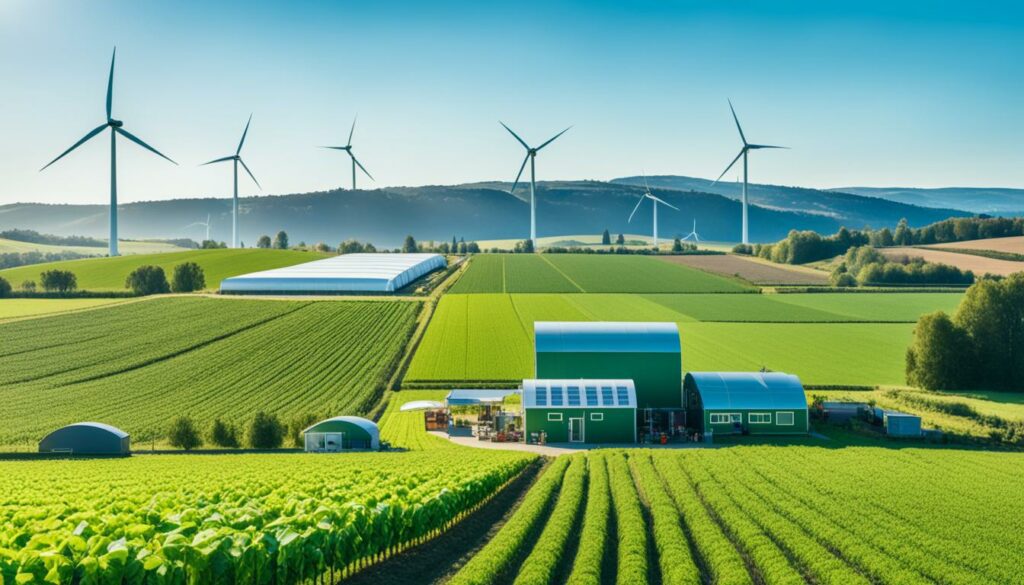
There are new and exciting changes happening in biodynamic farming. These innovations are boosting farm productivity without harming the environment. The German government wants 30% of farms to be organic by 2030. They have set out 24 steps to help reach this goal. These include improving labelling and data collection.
Even though farming costs are high and farms are closing, the industry is growing. People are more interested in buying food grown in eco-friendly ways. The German government is working with groups, like the IMAG, to help biodynamic farming thrive. In Berlin, there are protests for fair farmer prices and sustainable farming without GMOs.
| Statistic | Current Data |
|---|---|
| Total farms in Germany | 250,000 |
| Daily farm closures | 6 |
| Organic farms | 35,000 |
| German Government’s organic farming target by 2030 | 30% |
| Sales decrease in organic produce by Oct | 4.1% |
This strategy is key in making biodynamic farming a big part of Germany’s farming future. It inspires others through new farming ideas and strong community support.
Starting with biodynamic farming means knowing its heart. You must learn its core beliefs, tying together nature, spirituality, and farming. This holistic view is key to biodynamics.
Begin with Rudolf Steiner’s teachings. They introduce key ideas like using BD500 and BD501 for healthy soil and plants. Also, follow a biodynamic calendar, like Maria Thun’s, to sync planting times with the stars.
For newbies, the right info and help are crucial. Demeter is a key ally, offering certification and advice. Their global network of over 5,000 farms, with 150,000 hectares in Germany alone, supports best biodynamic practices.
Lean on the biodynamic community too. Talking to experts, joining workshops, and becoming part of farming groups all offer wisdom. These connections create a helping hand for those starting in biodynamics.
Biodynamic farming has deeply affected farming all around the world. Germany shows this influence well, with 42% of the world’s biodynamic farmland under its wing. This leadership highlights Rudolf Steiner’s vision in enhancing ecological farming and a complete view of agriculture. Processes in biodynamic farming aim to balance the health of soil, plants, and animals, promoting sustainable farming over time.
Worldwide, biodynamic methods spread over 255,051 hectares in 65 countries by 2022. This approach is not limited to a specific place, with over 50 countries embracing it. In the 1980s, the northeast U.S. began leading in community-supported agriculture, a model that promotes Steiner’s concepts for economic and social progress. Today, thousands of farms across North America follow these ideals, reflecting a broad acceptance of biodynamic principles.
The world of biodynamic research is growing, showing positive signs. There have been 147 articles from 1985 to 2017, where nearly half are very influential. 42 of these articles got highly rated, indicating strong value and relevance. Germany’s leading position, both in farm area and research, highlights the crucial role of biodynamic farming in future sustainable agriculture worldwide.
Biodynamic farming in Germany is a method of growing food. It’s based on Rudolf Steiner’s teachings. This approach connects ethical, ecological, and spiritual ideas. It sees soil, plants, and animals as part of a whole. Its goal is to farm in a way that gives back to the Earth.
In 1924, Rudolf Steiner spoke about farming with care. He was worried about harm to the Earth from chemicals. His approach, called biodynamic farming, looks at the earth, wildlife, and the skies as united. This is similar to organic farming’s focus on nature.
After Steiner’s lectures, biodynamic farming was first tried by a small group in Germany. These early farmers followed his ideas. As time went on, the practice grew. Even during hard times like war, interest in this eco-friendly farming style continued.
Biodynamic agriculture is all about working with nature. It values diverse crops and healthy soil. It believes that planting and harvesting are linked to the stars. By working in harmony with the Earth and the sky, it aims to be self-sustaining.
In biodynamic farming, the care of crops and soil is detailed. Farmers enrich the soil with compost to keep it healthy. They also look to the stars to guide when to plant and harvest. Animals are a key part of the farm too. They help keep the environment balanced.
Demeter certification means a product meets the highest biodynamic standards. It shows the farmers have followed strict rules. Inspections make sure the quality stays high.
Everyone from farmers to scientists and those who buy food play a part in Germany’s biodynamic community. They work together for a future with greener farming and new ideas. This makes Germany a place where ecological farming thrives.
In biodynamic farming, natural ways are used to keep the soil and environment healthy. This leads to farms that can last a long time. It’s good for the environment and for making sure the Earth’s soil stays rich.
Biodynamic farmers in Germany find it hard to balance money with their commitment to the Earth. They follow strict rules but they also need to sell what they grow. Sometimes, government decisions affect how much they can grow.
Yes, many German biodynamic farms have shown that this way of farming works. They prove that farming can help the Earth. These stories show that biodynamic farming can influence agriculture everywhere.
Biodynamic farming is like organic farming but it thinks about the ‘cosmic’ too. It’s more detailed, linking planting with nature’s cycles. This makes it stand out among nature-friendly farming.
Biodynamic farming in Germany looks set to keep growing with new ideas. The community is strong and focused on the future. It’s bringing new methods to agriculture worldwide.
To start with biodynamic farming, learn its basic principles. And then, get your farm ready the biodynamic way. Resources from groups like Demeter and others can help. They offer help for sustainable farming.